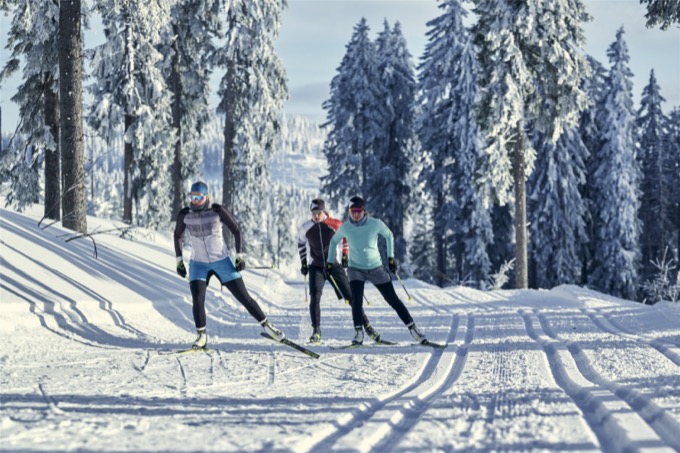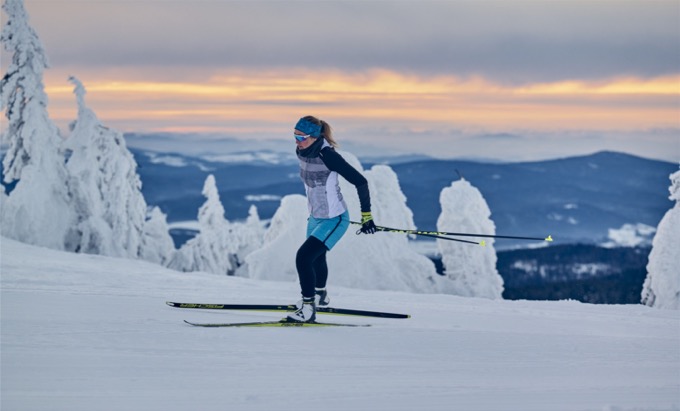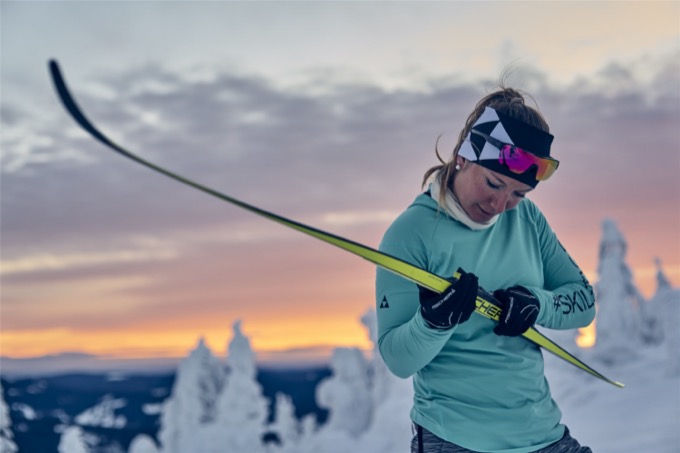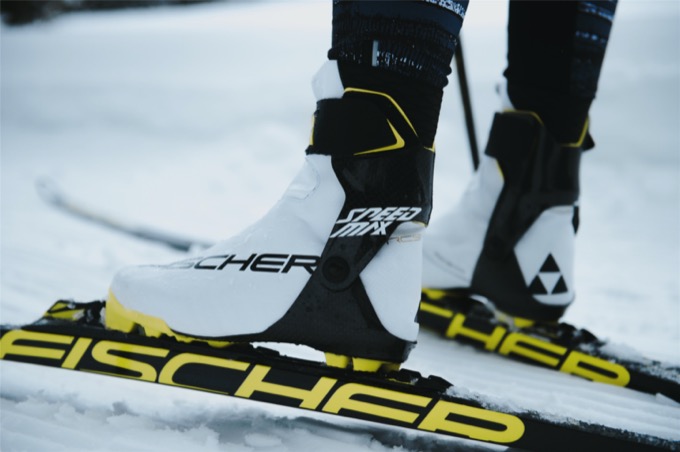
Table of Contents
Starting smart in skate skiing means making the right choices about your skate ski gear.
The right equipment will make all the difference when it comes time to learn the various skate skiing techniques.
Did you know we have instructional cross-country ski videos?
For skiers just getting started:
- Classic vs Skate Skiing: Which is right for you?
- First Day Lesson for Absolute Beginners
- Help for struggling skate skiers: The One Skate Dance Drill
Skate and Classic Cross Country Skiing
Skate skiing is one of the types of cross-country skiing done at Nordic ski areas where the snow is groomed and trackset. The other is called classic skiing, because it’s the older and more traditional style.
The mechanics and equipment for skate and classic ski equipment differ, but the skiing techniques share fundamental movements. Many Nordic skiers both skate and classic ski.
[Do you need help deciding between skate and classic skiing? This video will help: Classic vs Skate Skiing: Which is Right for You?]
For skate skiing, you will need:
- Skis
- Poles
- Boots and bindings
You’ll also need Country Ski Clothes and Accessories.
Can I use the same equipment for skate and classic skiing?
The short answer is no. Classic cross country and skate skis are constructed differently because the mechanics of how you push against the ski in skate and classic skiing are different.
- Classic skis are longer than skate skis.
- There are other differences that are less easy to see but are still important.
- Classic ski poles are shorter than skate ski poles.
- Classic boots are similar in shape to a running shoe, while skate boots have a high, supportive ankle cuff.
There is a type of cross-country ski boot called a pursuit boot (or combi boot) that works for classic and skate skiing.
You can save money by starting with that boot if you want to do both styles, but I think you’d be better off in the long run buying a classic or skate boots right from the start.
How Skate Skiing Works

Classic vs Skate Skiing
In classic skiing, the skis run in parallel tracks. There’s a sticky region on the base of a classic ski that the skier presses against the snow.
The sticky region, called the “grip zone”, sticks to the snow. The ski stops momentarily and gives the skier some friction to push against.
Skate skis work differently. In skate skiing, you move forward by pushing off the inside edge of the skis.
The ski doesn’t need to stop for you to push against it. In fact, you don’t want it to stop. That’s why skate skiing is faster than classic skiing.
Instead of the skis being parallel, skate skis are worked in a V-shape, with the tips wider apart than the tails.
Skate skis are shorter than classic skis, which makes them easier to manage with the feet in a V-stance.
Skate skiing is most fun on hard packed or groomed snow. A little fresh snow over groomed trails is OK, but skate skiing through deep snow is almost impossible.
Form and Function of a Skate Ski
Skate skis are flexed. The flex is called the camber.
If you hold the skis together with their bases touching, you can see the gap in between the skis. If you squeeze the gap, you can feel the stiffness of the camber.
When you push your skate ski against the snow, you compress the camber and dig the inside edge of the ski into the snow.
This gives you something to push against and also gives you a rebound spring at the end of your push which helps move you forward.
The action is reminiscent of ice skating, but the mechanics are different because skis are different from ice skates and snow is different from ice.
Skate Skis

Skate skis need to be fit to your height and weight because of the camber.
The ski needs to be stiff enough that it remains flexed when your weight in light on the ski, but soft enough that you can flatten out the ski when it comes time to push.
Fitting a ski takes skill, knowledge and experience, which is why you should buy from a local Nordic Ski shop or from an experienced skier who knows how to test the fit of a ski.
There’s no advantage to a recreational level skate ski over a race skate ski. Race skate skis are lighter and, in many ways, easier to handle.
The quality of the ski you buy will make a big difference to how quickly you learn and how much you enjoy skate skiing. This is not a good place to try to skimp unless you have to.
Do you need a fleet of skate skis?
Skate skis are built with different camber profiles and different flexibility at the tips to handle different snow conditions.
Most ski racers have a number of skis. They select a pair on race day depending upon conditions. For example, warmer conditions usually call for a skate ski with a high camber and softer tips. However it’s not 100% predictable which ski will be fastest in which conditions.
Most regular skiers are perfectly happy owning one pair of skate skis. It’s best if your skis are optimized to mid-range conditions or the conditions of where you’ll do most of your skiing.
Caring for your skate skis
The base of your skate skis need to be regularly treated with glide wax, which is applied with a special iron and scraped and brushed off on a special table, called a wax table or ski form.
You can do that at home, but it requires some specialized equipment and skill. It’s easier to drop off your skis at your local shop and have them do it.
When you buy your skis, ask for “ski ties” and don’t chose the wrap around velcro ones. Chose the sleeve-like ones. Use these whenever carrying your skis to help protect them.
A ski bag is also a good way to protect your skis from damage and makes it easier to manage multiple pairs of skis.
Skate Ski Poles
For a more in-depth discussion of poles, refer to this article, which includes an explanation of how to calculate the right pole length.
How to Buy Perfect Cross Country Ski Poles
The key points are:
- Poles matter because you actively push yourself along with both the skis and the poles.
- Poles come in various materials. Aluminum is heavy. Carbon is lovely – light and has a beautiful swing feel, but these poles are very expensive and more fragile. Composite poles are a nice, in between option and provide excellent mid-level value.
- Buy a pole with a harness, not a loop strap.
Skate Ski Boots and Bindings

The most important thing to consider when buying ski boots is comfort.
Skate boots should fit a little snugger than classic boots, but both should feel comfortable when you walk around the store.
Oversized, fleece-lined boots won’t do much to keep your feet warm and make it harder to ski with good technique. If you have trouble with cold feet, refer to the advice in this article:
What to Wear Cross Country Skiing
There are 2 systems of boots and bindings: NNN and SNS. NNN dominates the market and is the better choice, not because it works better, but because it’s most ubiquitous
The systems are not interchangeable. The boot system and binding system must be compatible. Check this, if you are buying used gear.
Boots, bindings and skis must match in terms of intended purpose. So, for example, you shouldn’t use a heavy backcountry boot on a lightweight race ski.
Manual bindings are superior to automatic bindings and well worth the extra, nominal cost. They are much easier to attach and detach and less likely to ice up.
Buying Advice
Buy for the skier you aspire to be, not the skier you are.
If you want to ski with the fast, graceful techniques used in cross country ski races, then you should buy race level gear.
Like everything else in life, you get what you pay for. Work out your budget (including clothes and accessories) and buy the best you can afford, reasonably.
The quality of your gear will affect the ease of learning and the joy of skiing.


